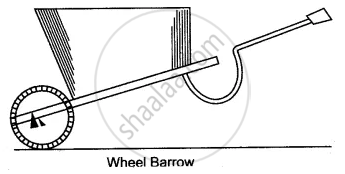Advertisements
Advertisements
प्रश्न
Fig 3.17 below shows a lever in use.

(a) To which class of lever does it belong?
(b) If FA = 80 cm, AB = 20 cm, find its mechanical advantage.
(c) Calculate the value of E.
उत्तर
(a) This is a class II lever.
(b) Given: FA=80 cm, AB = 20 cm, BF= FA+AB=100cm
Mechanical advantage M.A = `"𝐵𝐹"/"𝐴𝐹"`= `100/80` = 1.25
(c) Effort (E) = `"𝐿𝑜𝑎𝑑 (𝐿)"/"𝑀.𝐴"` = `5 /1.25` = 4 𝐾𝑔𝑓
APPEARS IN
संबंधित प्रश्न
Name a machine to obtain gain in speed ?
Give one example of a class I lever where mechanical advantage is more than one ?
Which type of levers have mechanical advantage always more than 1? Give reasons.
Give three examples for leavers of 1st order.
Give three examples for leavers of the third order.
The following belong to which class of lever?
The Physical balance
The following belong to which class of lever?
Pliers Tools
In the following diagram of a wheelbarrow, mark the fulcrum (F) and indicate the directions of load (L) and effort (E) with arrows.

What class of lever is it? Give one more example of the same class of lever.
What is a lever?
The length of a nut-cracker is 12 cm. A nut, when kept at a distance of 4 cm from its fulcrum, requires an effort of 100 gf to crack it. What force will be required to crack the nut without using the nut-cracker?
